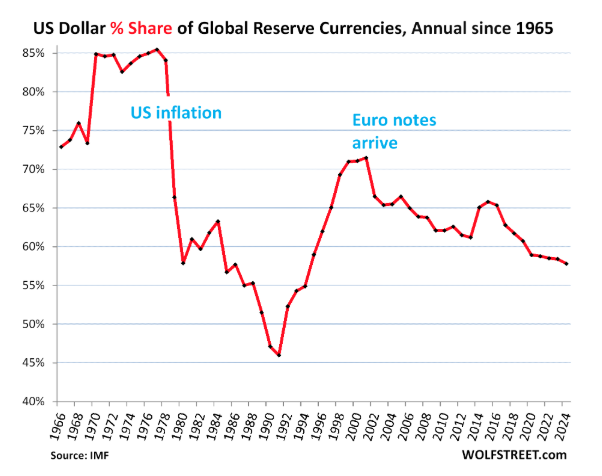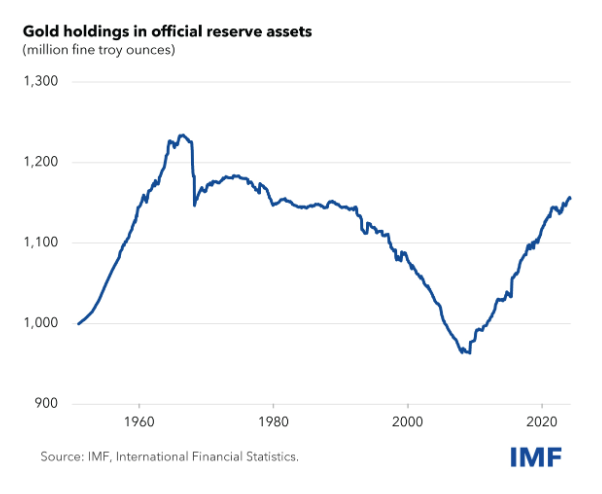Dollar's Reserve Status Losing Ground to Gold and Other Currencies
The U.S. dollar's status as the global reserve currency continues to erode, with gold and “non-traditional” reserve currencies gaining ground.
According to recently released IMF data, the dollar’s share of global reserve currencies slid further last year. Total holdings of dollar-denominated securities by central banks (excluding the Federal Reserve) fell by $59 billion in 2024.
As of the end of last year, dollars made up 57.8 percent of global reserves. That is the lowest level since 1994, representing a 7.3 percent decline in the last decade. In 2002, dollars accounted for about 72 percent of total reserves.
This isn’t the first surge of de-dollarization. The greenback’s share of reserves plunged during the inflationary years of the 1970s but recovered during the 1990s as price inflation cooled and U.S. budget deficits narrowed thanks to the post-Cold War “peace dividend.”
Today, the dollar faces a triple whammy - sticky price inflation, out-of-control federal spending driving massive budget deficits, and global wariness of the West’s weaponization of the dollar.
De-dollarization has accelerated since the U.S. and other Western nations imposed heavy sanctions on Russia in the wake of its invasion of Ukraine.
According to a report by the Atlantic Council, “In recent years, and especially since Russia’s invasion of Ukraine and the Group of Seven (G7)’s subsequent escalation in the use of financial sanctions, some countries have been signaling their intention to diversify away from dollars.”
What Is Replacing the Dollar?
If central banks are spurning dollars, what are they holding?
Increasingly, they are bolstering their reserve with gold.
Central bank gold demand topped 1,000 tonnes for the third straight year in 2024. To put that into perspective, central bank gold reserves increased by an average of just 473 tonnes annually between 2010 and 2021.
According to IMF data, between 2006 and 2023, central banks globally increased their official holdings by about 200 million troy ounces (6221 tonnes). This doesn’t account for the large amount of gold being purchased by the People’s Bank of China (and likely other countries) off the books.
In dollar terms, official central bank gold holdings amount to $3.65 billion.
Since 2005, Russia and China alone have added a combined 3,626 tonnes of gold to their official holdings. (Again, China has far more gold than this that is not included in the official disclosures.)
Other currencies are also gaining share as reserve instruments to the dollar’s detriment.
Euros account for about 20 percent of global reserves. Its share has remained steady over the years, ranging from a low of 19.1 percent in 2016 to a high of 21.3 percent in 2020.
The Chinese yuan has also lost ground as a reserve currency since 2022. According to WolfStreet, “Central banks have not been enamored with RMB-denominated assets due to China’s capital controls, the RMB’s convertibility issues, and other complexities.”
However, the following currencies are gaining status in the world of foreign reserves. (Courtesy of WolfStreet.)
- Japanese yen, 5.8% (YEN, purple).
- British pound, 4.7% (GBP, light blue).
- “All other currencies,” 4.6% (red).
- Canadian dollar, 2.8% (dotted green).
- Chinese renminbi, 2.2% (yellow).
- Australian dollar, 2.1% (black dotted).
- Swiss franc, 0.2% (black).
Why Does It Matter?
In a nutshell, the U.S. needs the world to need dollars.
The U.S. depends on this global demand for dollars supported by its reserve status to underpin its massive government. The only reason Uncle Sam can borrow, spend, and run massive budget deficits to the extent that it does is the dollar’s role as the world reserve currency. It creates a built-in global demand for dollars and dollar-denominated assets. This absorbs the Federal Reserve’s money creation and helps maintain dollar strength despite the Federal Reserve’s inflationary policies.
WolfStreet summed up the risk the U.S. faces as the dollar’s status continues to erode.
“The status of the U.S. dollar as the dominant global reserve currency has helped the US fund its twin deficits and thereby has enabled them: the huge fiscal deficit every year and the massive trade deficit every year. The reserve currency status comes from other central banks (not the Fed) having purchased trillions of USD-denominated assets such as Treasury securities, other government securities, corporate bonds, and even stocks. The dollar status as the dominant reserve currency has been crucial for the U.S., and as that dominance declines ever so slowly, risks pile up ever so slowly.”
While the threat isn’t immediate, a slowly growing pile eventually turns into a giant pile.
The world doesn't have to completely abandon the dollar to create negative impacts. Even a modest drop in the demand for dollars will ripple through the U.S. economy.
Even a modest de-dollarization of the world economy would cause a dollar glut. The value of the U.S. currency would further depreciate. That translates to more price inflation at home. In the worst-case scenario, the dollar could collapse completely, leading to hyperinflation.
********









 Mike Maharrey is a journalist and market analyst for
Mike Maharrey is a journalist and market analyst for 









